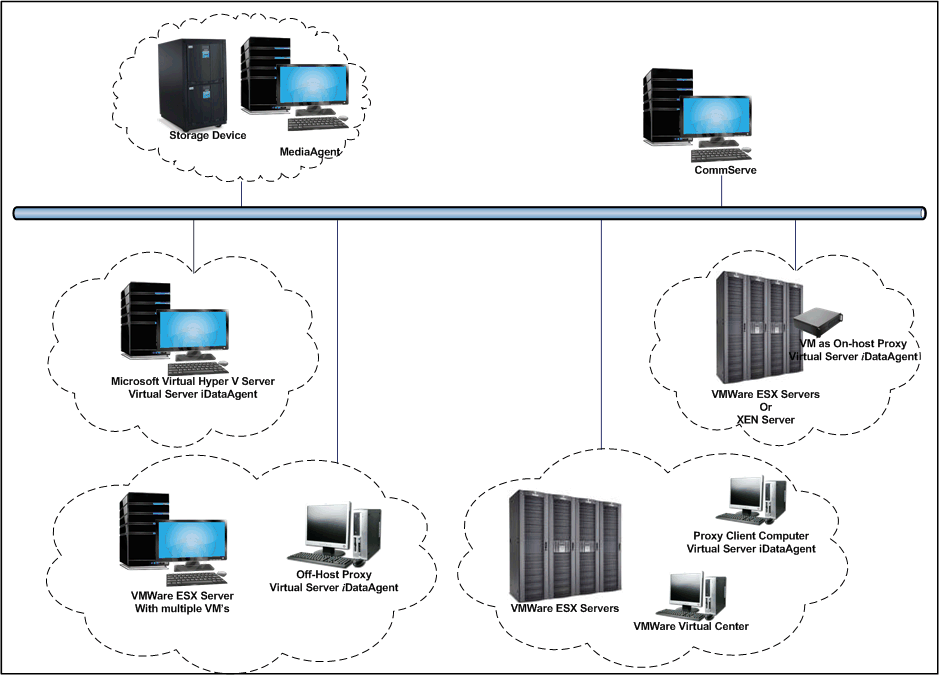 Minimal
Load on Host Resources
Minimal
Load on Host Resources
Table of Contents |
Where to go Next |
|
Complete Virtual Machine Protection Granular Recovery of Virtual Machine Data Minimal Load on Host Resources |
Walks you through the process of installing and configuring the Virtual Server iDataAgent for VMware. Walks you through the process of installing and configuring the Virtual Server iDataAgent for Microsoft Hyper-V. Walks you through the process of installing and configuring the Virtual Server iDataAgent for Xen. |
The Virtual Server iDataAgent provides a unified protection and recovery vehicle for all virtual machine data in your enterprise. In addition to complete protection of entire virtual machines for disaster recovery, the Virtual Server iDataAgent also provides more granular backup and recovery options that operate seamlessly with your virtual machine protection. Added options for automatic data discovery, deduplication, and reporting help ensure all your virtual machine data is easily traceable and retrievable whenever the need arises.
The Virtual Server iDataAgent offers the following key features:
The Virtual Server iDataAgent backs up a complete image of each virtual machine. This is accomplished by creating a snapshot of the virtual machine's disk, which includes the complete state of the virtual machine at the time of backup. Subsequently, the virtual machine disk can be easily restored and mounted back onto the host computer. The virtual machine is then ready for use.
In some cases, it may not be desirable to recover an entire virtual disk for a contained subset of data. For such circumstances, the Virtual Server iDataAgent provides the facility to restore individual files from a virtual disk. This negates the need to install a separate File System iDataAgent on each virtual machine or recover an entire virtual server disk for a mere subset of needed files. VMware backups also provide the facility to recover entire volumes with similar benefits.
 Minimal
Load on Host Resources
Minimal
Load on Host ResourcesThe Virtual Server iDataAgent is designed to ensure data protection and recovery operations consume as few resources on the host computer as possible. This is accomplished by placing the iDataAgent in the most resource-efficient location possible for mounting and transfer of data.
For VMware, the iDataAgent is installed on a proxy computer that can communicate with the Virtual Center or ESX Server being backed up. This proxy computer handles all the mounting and transfer of data from the host computer to the backup media. The proxy computer can be a separate physical machine, which is useful if the host computer already has a significant load placed on it through everyday operations. Alternatively, a virtual machine on the ESX Server or Virtual Center can be configured as the proxy computer if sufficient resources are available on the host and a separate, designated physical computer is not desired.
Similarly, for Xen, a proxy computer is also used. This proxy computer is always a virtual machine residing on the Xen server and is reserved specifically for data protection operations.
For Microsoft Virtual Servers and Hyper-V, the iDataAgent is installed directly on the host computer and utilizes Microsoft's embedded resource management capabilities to ensure backup and restore operations consume as few resources as possible.
The diagram on the right illustrates the combination of installations available for each virtualization vendor.
In any virtual environment, virtual machines are added or moved on a frequent basis. This rate of change can make it difficult to track whether newly created or moved virtual machines have been protected. The Virtual Server iDataAgent solves this problem by providing several options for automatically discovering virtual machines. The discovery process can add all new or moved virtual machines or a select group of virtual machines satisfying certain criteria to the backup content.
Deduplication provides a smarter way of storing data by identifying and eliminating the duplicate items in a data protection operation.
Deduplication at the data block level compares blocks of data against each other. If virtual machines contains blocks of data that are identical to each other, block level deduplication eliminates storing the redundant data and reduces the size of the data in storage. This dramatically reduces the virtual machine backup data copies on both the disk and tapes.
The Virtual Server iDataAgent documentation uses the following terminology:
Vendor |
The virtualization software being used (such as Hyper-V, VMware, or Xen). |
Disk-Level |
Backup and restore operations for virtual server disks. |
Volume-Level |
Backup and restore operations of volumes within a virtual server disk (such as a C: drive) |
File-Level |
Backup and restore operations of individual files and folders within a virtual server disk, such as documents and images. |
Guest Host |
A virtual machine. |
Guest OS |
The operating system running on the virtual machine (such as Windows or Linux). |
Proxy Computer |
A physical computer separate from the host computer on which the iDataAgent is installed. This computer facilitates most of the data movement from the host computer to the backup media. In some cases, this computer may be a virtual machine installed on the host computer. Such computers are referred to as a Proxy Virtual Machine. |